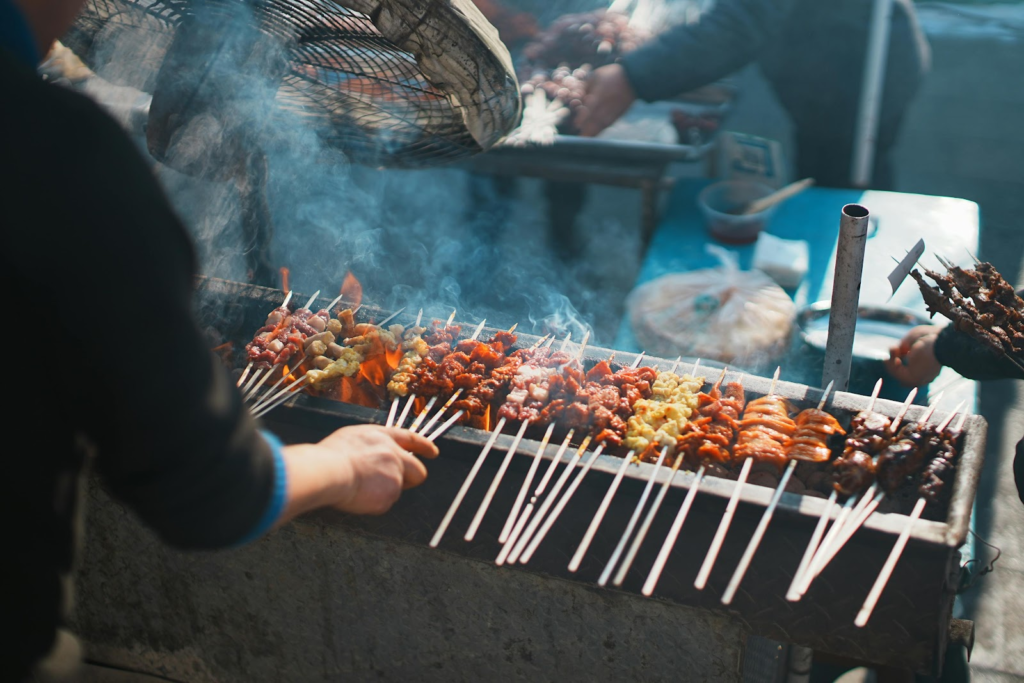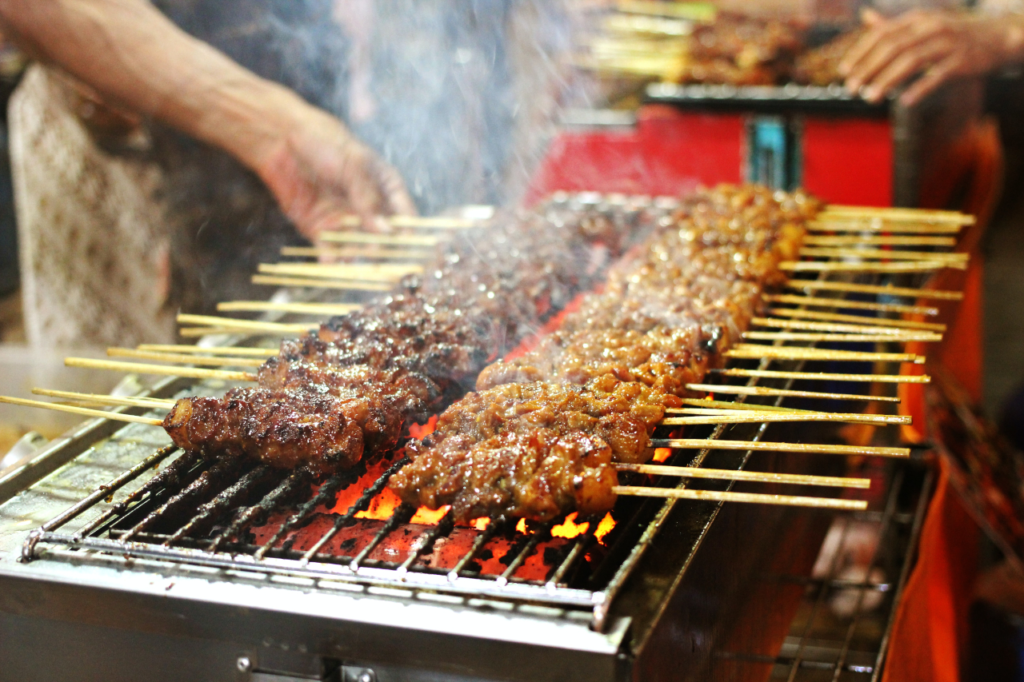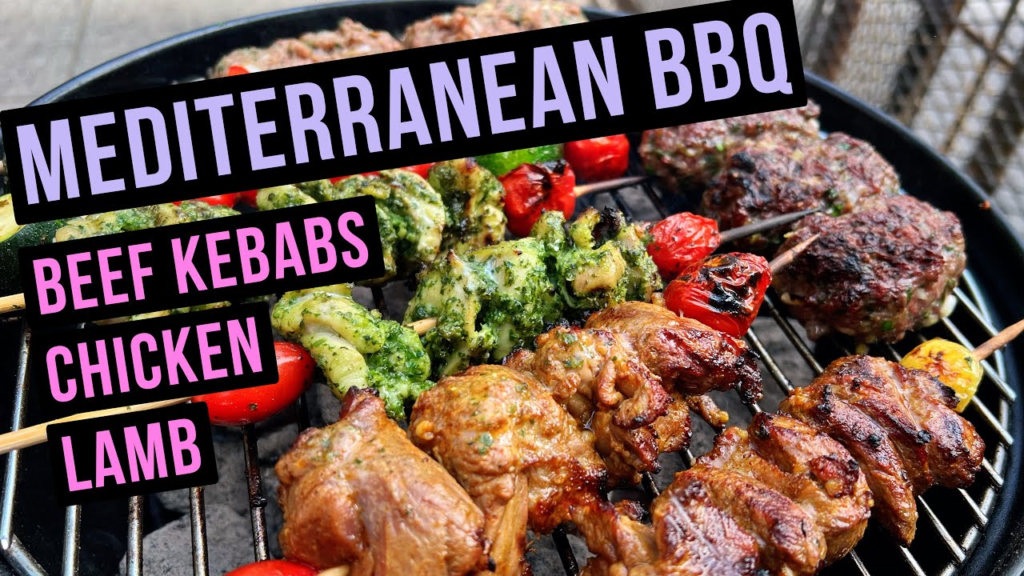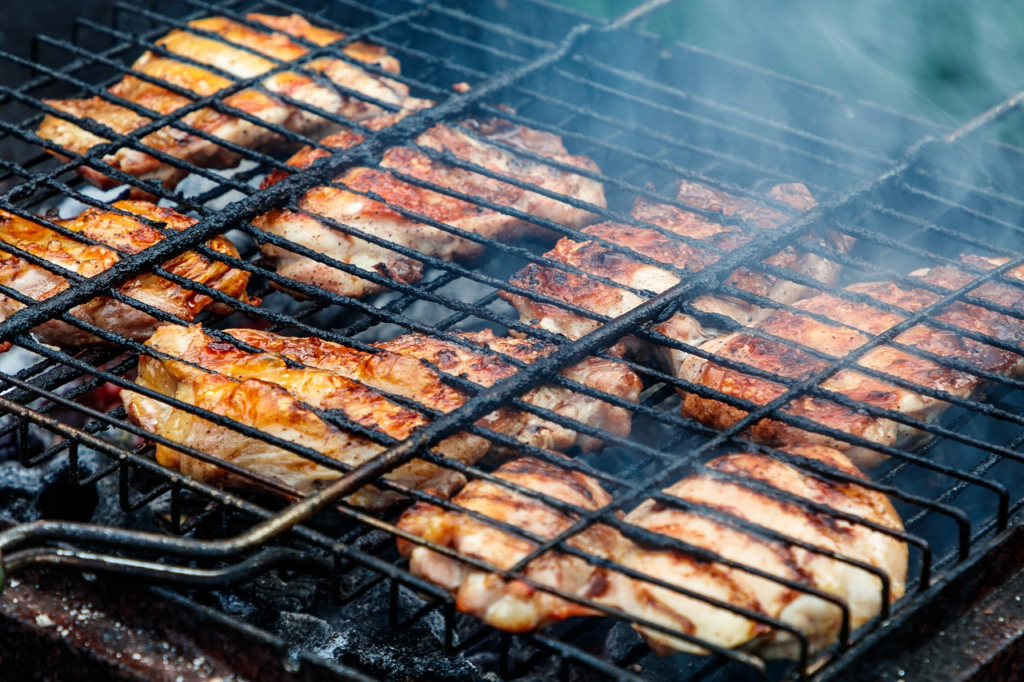Barbecue, or BBQ, is a culinary practice that transcends borders, bringing together diverse flavors, techniques, and traditions from around the world. From the smoky pits of Texas to the spicy grills of Korea, BBQ reflects the cultural richness and culinary ingenuity of its place of origin. This article delves into the various styles of international BBQ, exploring their unique characteristics, historical roots, and the contemporary trends shaping their evolution.

Table of Contents
The Origins and Evolution of BBQ
BBQ has ancient origins, with techniques dating back to prehistoric times when humans first learned to cook meat over an open flame. The term “barbecue” itself is believed to have originated from the Taíno people of the Caribbean, who used the word “barbacoa” to describe their method of slow-cooking meat over a wooden platform. This method was adopted and adapted by various cultures, each adding their unique touch to the practice.

American BBQ: Regional Variations

1. Texas BBQ:
- Characteristics: Known for its beef brisket, Texas BBQ is characterized by slow smoking with a dry rub, often featuring salt, black pepper, and sometimes cayenne or garlic powder. The focus is on the meat itself, with minimal sauce.
- Historical Roots: Influenced by German and Czech immigrants who settled in the region, Texas BBQ has evolved to prioritize beef, especially brisket, due to the abundance of cattle.
- Modern Trends: There’s a growing interest in sustainable sourcing and integrating more sophisticated smoking techniques, using a variety of woods like oak, pecan, and mesquite to add complex flavors (The Kitchn) (Cozymeal).
2. Kansas City BBQ:
- Characteristics: Famous for its pork ribs and burnt ends, Kansas City BBQ is known for its thick, tangy tomato-based sauce. The meat is typically cooked low and slow, resulting in a tender, flavorful product.
- Historical Roots: Kansas City’s BBQ scene blossomed in the early 20th century, influenced by the diverse African American community that brought with them rich culinary traditions.
- Modern Trends: Fusion BBQ is emerging, combining traditional Kansas City flavors with global influences such as Korean or Mexican spices and techniques (Exploding Topics) (The Daily Meal).
3. Carolina BBQ:
- Characteristics: Divided into Eastern and Western styles, Carolina BBQ is noted for its pork, especially whole hog in the East and pork shoulder in the West. Eastern style uses a vinegar-based sauce, while Western style incorporates a tomato and vinegar-based “Lexington Dip.”
- Historical Roots: The tradition of slow-cooking pork dates back to colonial times, reflecting the region’s agrarian economy and the influence of Native American cooking methods.
- Modern Trends: There is a resurgence of interest in heritage breeds of pigs and traditional whole-hog cooking, often accompanied by a focus on locally sourced ingredients (The Kitchn) (Cozymeal).
South American BBQ: Asado and Churrasco

1. Argentine Asado:
- Characteristics: Asado is a social event as much as it is a method of cooking. It involves grilling beef, pork, chicken, and sometimes lamb or goat over an open flame or embers. The meat is seasoned simply with salt.
- Historical Roots: Asado reflects the gaucho (cowboy) culture of Argentina, where cattle ranching has long been a central part of the economy.
- Modern Trends: Contemporary Argentine BBQ chefs are experimenting with aging techniques and incorporating non-traditional cuts of meat, along with a growing emphasis on organic and sustainable farming practices (Cozymeal) (The Daily Meal).
2. Brazilian Churrasco:
- Characteristics: Churrasco refers to a style of grilling meat on large skewers, typically over an open flame. Popular cuts include picanha (rump cap), alcatra (top sirloin), and fraldinha (flank steak).
- Historical Roots: Originating from the southern Brazilian region of Rio Grande do Sul, churrasco has its roots in the traditions of the gaúchos, the Brazilian cowboys.
- Modern Trends: Brazilian steakhouses (churrascarias) are incorporating more diverse menu options, including seafood and vegetables, reflecting a broader global culinary influence (The Daily Meal) (Exploding Topics).
Asian BBQ: A Fusion of Flavors

1. Korean BBQ:
- Characteristics: Known for its interactive dining experience, Korean BBQ involves grilling marinated meats such as bulgogi (beef) and galbi (short ribs) at the table. The meat is often accompanied by an array of side dishes called banchan.
- Historical Roots: Korean BBQ has evolved from traditional Korean royal court cuisine and local grilling practices, emphasizing communal dining and a balance of flavors.
- Modern Trends: The popularity of Korean BBQ continues to grow globally, with innovations such as the incorporation of non-traditional ingredients like cheese and Western sauces, as well as the use of modern grilling technologies (The Daily Meal) (The Kitchn).
2. Japanese Yakiniku:
- Characteristics: Yakiniku, meaning “grilled meat,” involves grilling bite-sized pieces of meat and vegetables over a charcoal or gas grill. It often includes a variety of meats such as beef, pork, and chicken, seasoned with soy sauce, garlic, and other marinades.
- Historical Roots: Yakiniku was influenced by Korean BBQ during the early 20th century but has since developed its distinct style, focusing on high-quality cuts of meat and simple seasonings.
- Modern Trends: Yakiniku restaurants are experimenting with premium cuts of wagyu beef and integrating international flavors, making it a sophisticated dining experience (Exploding Topics) (The Daily Meal).
3. Chinese BBQ:
- Characteristics: Chinese BBQ encompasses various regional styles, including Cantonese char siu (barbecued pork), Sichuan skewers, and Beijing roast duck. The common element is the use of aromatic spices and sauces, often involving soy sauce, hoisin, and five-spice powder.
- Historical Roots: Chinese BBQ traditions are deeply rooted in ancient cooking techniques, reflecting the country’s diverse culinary history and regional variations.
- Modern Trends: There is a growing trend towards street food-inspired BBQ, offering skewers and other grilled items in more casual settings, along with an emphasis on healthier, less oily preparations (The Kitchn) (Cozymeal).
Mediterranean BBQ: A Blend of Tradition and Innovation

1. Greek Souvlaki and Gyros:
- Characteristics: Souvlaki consists of skewered and grilled meat, typically pork, chicken, or lamb, often served with pita bread and tzatziki sauce. Gyros involve thinly sliced meat cooked on a vertical rotisserie.
- Historical Roots: These dishes are part of Greece’s ancient culinary traditions, influenced by the country’s geographical location and interactions with neighboring cultures.
- Modern Trends: Greek BBQ is being reimagined with a focus on artisanal ingredients, including organic meats and homemade pita bread, along with innovative marinades and sauces (The Kitchn) (Exploding Topics).
2. Middle Eastern Kebabs:
- Characteristics: Middle Eastern BBQ is known for its diverse range of kebabs, including shish kebabs, kofta kebabs (ground meat), and shawarma (meat cooked on a vertical rotisserie). These dishes often feature a blend of spices such as cumin, coriander, and paprika.
- Historical Roots: Kebabs have ancient origins, with evidence of similar cooking methods dating back to the Mesopotamian civilization. The use of spices reflects the region’s historical role as a hub for the spice trade.
- Modern Trends: Contemporary Middle Eastern BBQ is incorporating more plant-based options, such as vegetable kebabs and falafel, catering to the growing demand for vegetarian and vegan cuisine (The Daily Meal) (Exploding Topics).
African BBQ: Rich in Flavor and Tradition

1. South African Braai:
- Characteristics: Braai is a traditional South African BBQ involving grilling meat over wood or charcoal. Popular meats include boerewors (sausage), lamb chops, and steaks, often accompanied by sides like pap (maize porridge) and chakalaka (spicy vegetable relish).
- Historical Roots: Braai is a significant cultural practice in South Africa, reflecting the country’s diverse heritage and the social importance of communal eating.
- Modern Trends: There is an increasing emphasis on using locally sourced and sustainable ingredients, along with the incorporation of global flavors and techniques (Exploding Topics) (Cozymeal).
2. Nigerian Suya:
- Characteristics: Suya is a popular Nigerian street food consisting of skewered and grilled meat, typically beef or chicken, seasoned with a spicy peanut-based rub known as yaji. It is often served with sliced onions and tomatoes.
- Historical Roots: Suya has its roots in the culinary traditions of the Hausa people of northern Nigeria, where it is a staple of street food culture.
- Modern Trends: Nigerian chefs are experimenting with suya by incorporating it into more upscale dining settings and fusion dishes, such as suya tacos or suya pizza (The Kitchn) (Cozymeal).
European BBQ: Diverse and Innovative

1. British BBQ:
- Characteristics: British BBQ is an eclectic mix, often involving grilled sausages, burgers, and various meats, complemented by sides like coleslaw, potato salad, and grilled vegetables.
- Historical Roots: While BBQ is not traditionally associated with British cuisine, the influence of American BBQ culture has grown, leading to
Conclusion
The journey through the world of international BBQ reveals a rich tapestry of culinary practices deeply rooted in cultural traditions and historical influences. From the robust, beef-centric BBQ of Texas to the communal and celebratory Argentine Asado, each style offers a unique approach to cooking meat over an open flame, reflecting the local ingredients, tastes, and social customs of its origin.
American BBQ showcases a range of regional variations, with Texas, Kansas City, and Carolina each bringing distinct flavors and techniques to the table. These styles have evolved through the contributions of diverse communities and continue to innovate, integrating global influences and modern culinary trends.
In South America, the art of grilling is epitomized by Argentine Asado and Brazilian Churrasco, both of which emphasize simplicity, high-quality meat, and social dining experiences. Similarly, the rich and diverse flavors of Asian BBQ, from Korean and Japanese to Chinese traditions, highlight a balance of communal cooking and complex marinades.
Mediterranean BBQ, including Greek and Middle Eastern varieties, brings together ancient cooking methods with modern twists, creating flavorful and aromatic dishes that continue to captivate the palate. African BBQ, particularly South African Braai and Nigerian Suya, reflects the continent’s vibrant cultural heritage and evolving culinary landscape.
European BBQ, influenced by American practices, is gaining popularity with its eclectic mix of grilled meats and innovative side dishes, demonstrating the adaptability and global appeal of BBQ.
In conclusion, BBQ is more than just a method of cooking; it is a celebration of culture, history, and community. As contemporary trends push the boundaries of traditional BBQ, integrating sustainable practices, fusion cuisines, and health-conscious choices, the essence of BBQ as a communal and flavorful culinary experience remains timeless. This global culinary journey underscores the universal love for BBQ and its ability to bring people together across different cultures and backgrounds.
for more information, visit https://www.lloydsfood.com/
FAQ
Q1: What is the origin of the term “barbecue”?
A1: The term “barbecue” is believed to have originated from the Taíno people of the Caribbean, who used the word “barbacoa” to describe their method of slow-cooking meat over a wooden platform.
Q2: What are the main characteristics of Texas BBQ?
A2: Texas BBQ is known for its beef brisket, which is slow-smoked with a dry rub featuring salt, black pepper, and sometimes cayenne or garlic powder. The emphasis is on the meat itself, often with minimal sauce.
Q3: How does Kansas City BBQ differ from other styles?
A3: Kansas City BBQ is famous for its pork ribs and burnt ends, and it is characterized by a thick, tangy tomato-based sauce. The meat is typically cooked low and slow, resulting in a tender, flavorful product.
Q4: What distinguishes Carolina BBQ?
A4: Carolina BBQ is divided into Eastern and Western styles. Eastern Carolina BBQ uses a vinegar-based sauce and often involves whole hog cooking, while Western Carolina BBQ (Lexington style) incorporates a tomato and vinegar-based sauce, focusing on pork shoulder.
Q5: What is Argentine Asado?
A5: Argentine Asado is a social event as well as a cooking method. It involves grilling beef, pork, chicken, and sometimes lamb or goat over an open flame or embers, seasoned simply with salt. It reflects the gaucho (cowboy) culture of Argentina.
Q6: What are the key features of Brazilian Churrasco?
A6: Brazilian Churrasco involves grilling meat on large skewers over an open flame. Popular cuts include picanha (rump cap), alcatra (top sirloin), and fraldinha (flank steak). It originated from the southern Brazilian region of Rio Grande do Sul.
Q7: What makes Korean BBQ unique?
A7: Korean BBQ is known for its interactive dining experience, where marinated meats like bulgogi (beef) and galbi (short ribs) are grilled at the table. It is accompanied by various side dishes called banchan, emphasizing communal dining and a balance of flavors.
Q8: How is Japanese Yakiniku different from other BBQ styles?
A8: Yakiniku, meaning “grilled meat,” involves grilling bite-sized pieces of meat and vegetables over a charcoal or gas grill. It often includes high-quality cuts of meat seasoned with soy sauce, garlic, and other marinades.
Q9: What are the traditional elements of Chinese BBQ?
A9: Chinese BBQ includes various regional styles such as Cantonese char siu (barbecued pork), Sichuan skewers, and Beijing roast duck. It typically involves aromatic spices and sauces, including soy sauce, hoisin, and five-spice powder.
Q10: What is Greek Souvlaki and Gyros?
A10: Souvlaki consists of skewered and grilled meat, often served with pita bread and tzatziki sauce, while Gyros involve thinly sliced meat cooked on a vertical rotisserie. Both are part of Greece’s ancient culinary traditions.
Q11: Describe Middle Eastern Kebabs.
A11: Middle Eastern BBQ features a diverse range of kebabs, including shish kebabs, kofta kebabs (ground meat), and shawarma (meat cooked on a vertical rotisserie). These dishes are seasoned with spices such as cumin, coriander, and paprika.
Q12: What is South African Braai?
A12: Braai is a traditional South African BBQ involving grilling meat over wood or charcoal. Popular meats include boerewors (sausage), lamb chops, and steaks, often accompanied by sides like pap (maize porridge) and chakalaka (spicy vegetable relish).
Q13: What makes Nigerian Suya special?
A13: Suya is a popular Nigerian street food consisting of skewered and grilled meat, typically beef or chicken, seasoned with a spicy peanut-based rub known as yaji. It is often served with sliced onions and tomatoes.
Q14: How has British BBQ evolved?
A14: British BBQ is an eclectic mix, often involving grilled sausages, burgers, and various meats, complemented by sides like coleslaw, potato salad, and grilled vegetables. Influences from American BBQ culture have contributed to its growth and diversity.
Q15: What are some contemporary trends in international BBQ?
A15: Contemporary trends in international BBQ include sustainable sourcing, fusion BBQ combining traditional and global flavors, the use of non-traditional ingredients, innovative grilling technologies, and a focus on healthier, organic, and locally sourced ingredients.
